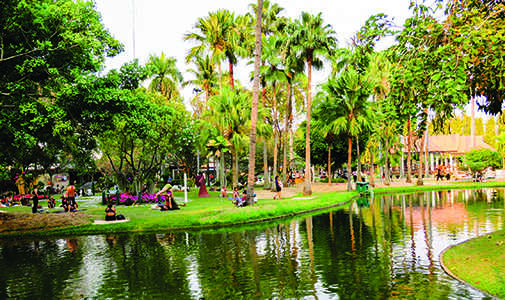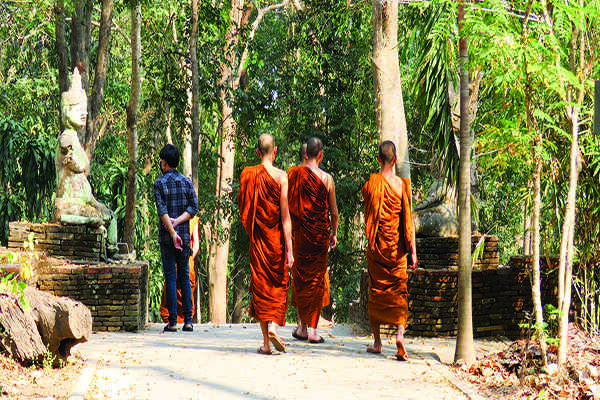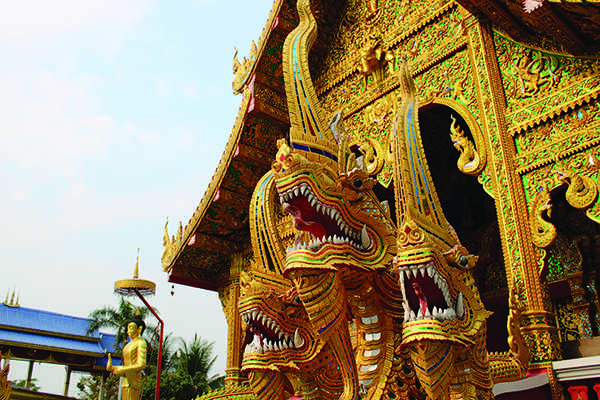I step, barefoot, on a path of smooth stones that were artfully laid down by devoted hands. Above me, an intricate stupa (or chedi) is positioned at the pinnacle of an ornate Buddhist temple. I am visiting in my quest to learn more about the imagery, myths, and symbols of Thailand’s Buddhist faith. They have surrounded me since I moved here in 2016 from the stressful, and ultimately unfulfilling, life I was living at the time.
The word “gratitude” is a bit of a cliché, but every time I step outside in Thailand, surges of gratitude, and excitement, rush over me. History echoes as I walk past the crumbling ruins of ancient temples, statues of proud kings, and the colorful depictions of mythical beasts that are never far away in Thailand. The visual landscape here ambushes the Western notion of sober, muted devotion. Golden statues of serene Buddhas, or boggle-eyed serpents in emerald-green seem frivolous to an eye raised on pious Christian saints in shapeless robes. But that’s Thailand. When the very landscape is a riot of day-glo greens, hot pink tropical flowers, and flaming sunrises, how could folk art be anything less?
Chedis in Thailand are not only fascinating, as their stepped shape represents stages that one must go through to attain enlightenment, but they are also the keepers of history. They are reliquaries that house the most sacred of objects—relics of the Buddha himself—or, more often, historic artefacts to be protected from the clutches of time.
Living in Chiang Mai, I often feel a bit like Dorothy in Oz. My old life was routine, black and white, completely predictable. But I have nose-dived suddenly into a new world, and like Dorothy’s, it is a joyous technicolor.
Chiang Mai is a delightful place to spend your days. It has the all the convenience of a large city but still offers the simple living of a small town. Rentals here have dropped in price by 20% since COVID-19 changed global travel. But tourists are beginning to trickle back with the revised quarantine measures, and gently the city is returning to its usual verve and vigor. A modest but liveable studio condo will set you back just $233 per month.
A modest condo costs just $233 a month.
“I didn’t chose a condo,” says local restaurateur Rudi Goodman, who hails from California. “I wanted to have pets, so I found a two-bedroom white bungalow with a sunken kitchen about a 12-minute drive from the old city. I have a leafy front yard for the dogs and I pay only $250 per month. I looked hard for a really good deal. They are not too difficult to find.”
It’s true, there are a lot of rental options here, and getting your accommodation needs settled for such a minimal outlay perhaps frees the mind a little from the tyranny of trying to make rent. That allows expats in this part of the world to focus on less material things. People who move here feel it. They enjoy the city’s spirit and colors and flavors. But Chiang Mai delivers more to an expat than just cultural beauty. It is a place that stimulates your curiosity and sense of adventure.
Back at the chedi, I see a cluster of Thai locals pouring water into a delicate golden model bird. They then use a primitive winch system to fly it toward the structure. I stand mesmerized. Group anticipation floats in the air along with the bird, and everyone stands to watch. As the nok (bird) ascends to the top of the spire, it bumps into the side. The impact spills water onto the top of the chedi. I watch the Thai people laugh and smile as the water trickles down and around a Buddha image that is recessed into the structure.
I know nothing of this ritual. Except that it is sweet and brings joy to the people performing it. So, I add it to the list of things I need to know more about.
I am on a journey living in Chiang Mai. It is a quest, really, for understanding that goes much deeper than figuring out what to order at a street-food vendor or which branch of 7-Eleven stocks Dr. Pepper. Research boosts my imagination, and brings to life the images of mythical creatures that I walk among daily. For me, it’s one of the reasons to live here, but every expat has their own motivations.
“There are multiple reasons for wanting to live in Chiang Mai,” says family man Kevin Painter, originally from Texas.
“We particularly enjoy the relative safety and security of the region. The locals look down on stealing, are very devout, and take good manners to a level we have lost in the West. Even though the cost of living is amazingly affordable, the scenery is beautiful, and the weather is always warm, above all, safety for our family was the bar we settled for.”
I visit temples at least once every week. It is especially a treat when I stumble upon one with very old murals. There is something touching about messages from the past, the gift of insights from hundreds of years ago. These older murals are difficult to find; they are certainly not advertised in tourist brochures. This is another reason why gazing upon them is so special—it feels like an insider secret. Some days I feel like Howard Carter gazing upon Tutankhamun’s tomb after its 3,000 years of buried slumber. Just recently I stood at the doorway of Wat Tak Kham in Mae Thaeng, a short 30-minute drive from Chiang Mai. A solitary monk was preparing the ceremonial string.

Yep, it’s really just a roll of cord, but here, it’s used as a way to connect the Buddha image to all the worshippers during special religious ceremonies. I love that a roll of string, normally such a simple everyday object, can be so powerful as to connect devotees to the spirit of the Buddha. It’s a beautiful thought, and it’s the ideal illustration of just how inclusive the ceremonies are. Nobody is left out.
That’s true of Thai society in general, too. You’re not frozen out as an expat here, and you don’t need to be Thai to enjoy what’s on offer. Personally, my friends and I love Payap University’s Life-Long Learning courses (see: Inter payap.ac.th/life-long-learning). The courses include field trips to historic sites or artistic workshops in subjects like ceramics or sketching. They’re part of what got me so interested in temples, murals, and the whole collection of stories, historical figures, and mythical beasts that are such an integral part of Thai life.
Devotional art in Thailand is shamefully underrated. We Westerners still carry vestiges of the Victorian era in our snobbery toward the art of Southeast Asia. That’s a mistake that I, for one, won’t make. In my view, the artistry within Thailand’s many temples is equal in beauty, content, form, and feel to what you’d see in cathedrals in Europe—just different. To think that I am absolutely surrounded by it here in Chiang Mai makes it a joy to get out of bed every day and go adventuring.
My most recent adventure was at Wat Chammathewi. The temple celebrates the 7th-century tale of Queen Chammathewi, who established Lamphun— an older city close to Chiang Mai. The temple walls tell her story from birth (she was found as a baby on a lotus flower by a hermit) to her supreme military prowess. When an arrogant prince from the neighboring Mon kingdom demanded her hand in marriage, and was rejected, he declared war. Chammathewi, then a 20-year-old princess, led the Lavo troops to victory herself.
Her best-known exploit is how she cunningly ripped the hem section off her skirt and made it into a turban-like hat to send to her enemy. In Thai folklore, the hemline of a woman’s skirt is filled with bad energy. Queen Chammathewi outwitted her opponent, as he had nothing but ill fortune after donning his new hat.
Chammathewi’s temple is actually a few miles southeast of the city center, but that’s not a problem in a country where getting around is as simple as hailing a passing pickup truck taxi (they’re called song theaws, and perhaps “taxi’ is a little misleading). These are a cheap shared transport option, where you sit on a bench and bounce along with your fellow travelers. The fare is set at 90 cents and they operate only within the city.
Shared taxi fares are set at 90 cents in the city.
The latest form of transport is GRAB— taxis that are ordered through an app. They’re very cheap and popular with expats. There’s also a bus service, stopping at popular destinations for 90 cents.
And there are plenty of places to go. Lorraine Griggs, an expat from Maryland, spoke to me about her favorite dining options among Chiang Mai’s 6,000 restaurants. “I like vegetarian and vegan food, which can mean a large plateful of curries, stews, and rice at the local mall’s food court for $1.50, or a delicious bean burrito that feeds two for $3. My favorite restaurant serves up breakfast, lunch, or dinner for $5 to $7 a meal.”
I’m a big fan of the Chiang Mai street food scene. A bowl of khao soi soup is the quintessential local specialty. Chili, curry spices, and garlic in a coconut broth with two layers of noodles—the first is soft, the second is deep-fried and crunchy—pure heaven.
At first, I was a little too judgmental of some of the “Thai” aspects of Thailand. I recall not being too impressed with the Naga (serpent-like creatures) that stand at the temple doors in defiant protection. Their large toothy mouths didn’t come across as particularly friendly, nor their googly wild eyes. But once I learned the stories about the Naga, I began to change my mind.
The most important Naga was Mucalinda. Once, when the Buddha was trying to reach enlightenment to save mankind from suffering, it began to rain heavily. The Naga, recognizing that the Buddha was trying to do something important, raised his seven heads and created a hood to protect the Buddha from the rain. And so the Buddha was not disturbed.
When the Buddha began teaching, the Naga was very impressed and asked if he could become a monk and study. Sadly for the Naga, the Buddha would allow only men into the fold. (This is where my sympathies for the Naga began.)
In Northern Thailand, many believe Nagas still roam. I have driven through plains where they are supposed to dwell and kept my eye out, but alas, have never caught a glimpse. Nevertheless, at every temple I now visit, I see the Naga with new eyes, and notice that they are all different.
Expats love to roam this land. There is so much to discover, and it costs so little.
Day trips from Chiang Mai are easy, as roads are smooth and well signposted. Also, the airport and train station are very accessible to the Old City. Adventures to small villages, mountains, waterfalls, archaeological sites, or temples will give you a reason to get up and go in the morning.
If you don’t want to explore the temples, that’s OK too. The city is packed with atmospheric cafés and restaurants.
It’s possible to stay overnight in a jungle hut for as little as $10 or luxuriate in a top resort with pools cascading down the mountains for $100.
“A life of adventure is defined by not knowing exactly what will transpire in the course of a day; it’s a state of mind requiring a heightened awareness of pitfalls and opportunities,” says Amy Williams D’Apice, expat, artist, and adventurer. “Unexpected beauty appears when we abandon old ideas of what that looks like.”
Amy has developed a lifestyle traveling on her motor scooter with the aim to simply discover and enjoy. It’s fitting. Chiang Mai really has a “choose your own adventure” feel to it.
Another mythical creature that roams Northern Thailand quite freely, I’m told, is the Sihuhata. This one’s a favorite of mine. It has five eyes, four ears, and has a sort of four-legged mammal look to it. Oh, and if you feed it burning hot charcoal it will provide you with gold from its behind. The Sihuhata is here to remind us of compassion. If we feed it (being compassionate) we will be rewarded. I have found statues of this creature and yes, it was surrounded by offerings of burning charcoal. If I do happen upon a gold nugget, I will know exactly where it came from.
Update: Nok Quest completed. Just minutes ago, I discovered the mystery of the golden bird at the chedi. It is called a Hong and is a celestial swan. It often carries a bell in its beak. Legend has it that when the wind moves the bell, the chime lifts prayers up to heaven.
How could you be unhappy living among stories, folklore, and creatures such as these?



